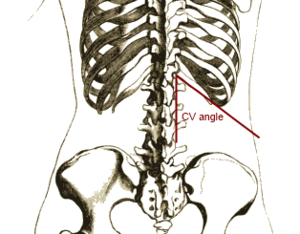Costovertebral angle tenderness: Difference between revisions
CSV import Tags: mobile edit mobile web edit |
CSV import |
||
| Line 1: | Line 1: | ||
{{DISPLAYTITLE:Costovertebral Angle Tenderness}} | |||
== | ==Costovertebral Angle Tenderness== | ||
[[File:CVangle.png|thumb|right|Diagram showing the location of the costovertebral angle.]] | |||
'''Costovertebral angle tenderness''' (CVAT), also known as '''Murphy's punch sign''' or '''Pasternacki's sign''', is a medical test in which pain is elicited by percussion of the area of the back overlying the [[kidneys]]. This test is used to assess for [[pyelonephritis]] or other kidney-related conditions. | |||
== | ==Anatomy== | ||
The [[costovertebral angle]] is formed by the 12th rib and the vertebral column. It is located on the posterior side of the body, just lateral to the spine. The [[kidneys]] are retroperitoneal organs that lie in this region, making it a useful site for clinical examination. | |||
Costovertebral angle tenderness is a | ==Clinical Significance== | ||
Costovertebral angle tenderness is a classic sign of [[pyelonephritis]], which is an infection of the [[kidney]]. It can also indicate other conditions such as [[renal calculi]] (kidney stones) or [[hydronephrosis]]. The presence of CVAT suggests inflammation or infection of the kidney. | |||
== | ==Examination Technique== | ||
To assess for costovertebral angle tenderness, the examiner places one hand flat over the costovertebral angle and gently taps it with the other hand. A positive sign is indicated by the patient experiencing pain upon this percussion. | |||
==Differential Diagnosis== | |||
While CVAT is commonly associated with [[pyelonephritis]], it is important to consider other potential causes of flank pain, such as: | |||
* [[Renal calculi]] | |||
* [[Hydronephrosis]] | |||
* [[Polycystic kidney disease]] | |||
* [[Musculoskeletal pain]] | |||
== | ==Related pages== | ||
* [[Pyelonephritis]] | |||
* [[Kidney]] | |||
* [[Renal calculi]] | |||
* [[Hydronephrosis]] | |||
[[Category:Medical signs]] | |||
[[Category:Medical | |||
[[Category:Nephrology]] | [[Category:Nephrology]] | ||
Latest revision as of 05:17, 16 February 2025
Costovertebral Angle Tenderness[edit]

Costovertebral angle tenderness (CVAT), also known as Murphy's punch sign or Pasternacki's sign, is a medical test in which pain is elicited by percussion of the area of the back overlying the kidneys. This test is used to assess for pyelonephritis or other kidney-related conditions.
Anatomy[edit]
The costovertebral angle is formed by the 12th rib and the vertebral column. It is located on the posterior side of the body, just lateral to the spine. The kidneys are retroperitoneal organs that lie in this region, making it a useful site for clinical examination.
Clinical Significance[edit]
Costovertebral angle tenderness is a classic sign of pyelonephritis, which is an infection of the kidney. It can also indicate other conditions such as renal calculi (kidney stones) or hydronephrosis. The presence of CVAT suggests inflammation or infection of the kidney.
Examination Technique[edit]
To assess for costovertebral angle tenderness, the examiner places one hand flat over the costovertebral angle and gently taps it with the other hand. A positive sign is indicated by the patient experiencing pain upon this percussion.
Differential Diagnosis[edit]
While CVAT is commonly associated with pyelonephritis, it is important to consider other potential causes of flank pain, such as: